Related Research Articles

Basic copper carbonate is a chemical compound, more properly called copper(II) carbonate hydroxide. It can be classified as a coordination polymer or a salt. It consists of copper(II) bonded to carbonate and hydroxide with formula Cu2(CO3)(OH)2. It is a green solid that occurs in nature as the mineral malachite. It has been used since antiquity as a pigment, and it is still used as such in artist paints, sometimes called verditer, green bice, or mountain green.

Malachite is a copper carbonate hydroxide mineral, with the formula Cu2CO3(OH)2. This opaque, green-banded mineral crystallizes in the monoclinic crystal system, and most often forms botryoidal, fibrous, or stalagmitic masses, in fractures and deep, underground spaces, where the water table and hydrothermal fluids provide the means for chemical precipitation. Individual crystals are rare, but occur as slender to acicular prisms. Pseudomorphs after more tabular or blocky azurite crystals also occur.
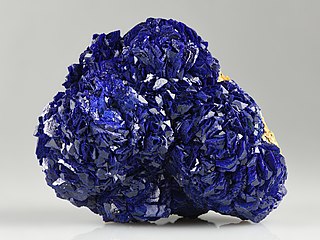
Azurite or Azure spar is a soft, deep-blue copper mineral produced by weathering of copper ore deposits. During the early 19th century, it was also known as chessylite, after the type locality at Chessy-les-Mines near Lyon, France. The mineral, a basic carbonate with the chemical formula Cu3(CO3)2(OH)2, has been known since ancient times, and was mentioned in Pliny the Elder's Natural History under the Greek name kuanos (κυανός: "deep blue," root of English cyan) and the Latin name caeruleum. Copper (Cu2+) gives it its blue color.
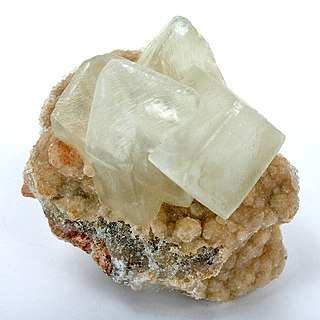
Smithsonite, also known as zinc spar, is the mineral form of zinc carbonate (ZnCO3). Historically, smithsonite was identified with hemimorphite before it was realized that they were two different minerals. The two minerals are very similar in appearance and the term calamine has been used for both, leading to some confusion. The distinct mineral smithsonite was named in 1832 by François Sulpice Beudant in honor of English chemist and mineralogist James Smithson (c. 1765–1829), who first identified the mineral in 1802.

Cuprite is an oxide mineral composed of copper(I) oxide Cu2O, and is a minor ore of copper.

Chrysocolla ( KRIS-ə-KOL-ə) is a hydrous copper phyllosilicate mineral and mineraloid with the formula Cu
2 – xAl
x(H
2Si
2O
5)(OH)
4⋅nH
2O (x < 1) or (Cu, Al)
2H
2Si
2O
5(OH)
4⋅nH
2O).
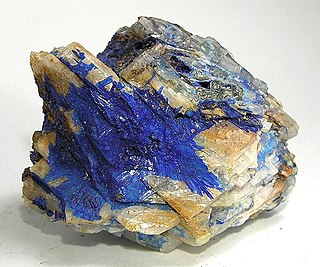
Linarite is a somewhat rare, crystalline mineral that is known among mineral collectors for its unusually intense, pure blue color. It is formed by the oxidation of galena and chalcopyrite and other copper sulfides. It is a combined copper lead sulfate hydroxide with formula PbCuSO4(OH)2. Linarite occurs as monoclinic prismatic to tabular crystals and irregular masses. It is easily confused with azurite, but does not react with dilute hydrochloric acid as azurite does. It has a Mohs hardness of 2.5 and a specific gravity of 5.3 – 5.5.
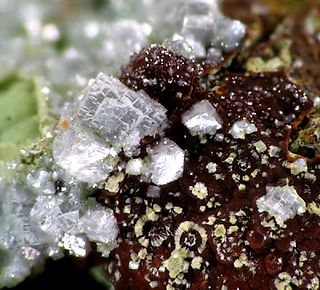
Otavite is a rare cadmium carbonate mineral with the formula CdCO3. Otavite crystallizes in the trigonal system and forms encrustations and small scalenohedral crystals that have a pearly to adamantine luster. The color is white to reddish to yellow brown. Its Mohs hardness is 3.5 to 4 and the specific gravity is 5.04. Associated minerals include azurite, calcite, malachite, and smithsonite.

Copper(II) hydroxide is the hydroxide of copper with the chemical formula of Cu(OH)2. It is a pale greenish blue or bluish green solid. Some forms of copper(II) hydroxide are sold as "stabilized" copper(II) hydroxide, although they likely consist of a mixture of copper(II) carbonate and hydroxide. Cupric hydroxide is a strong base, although its low solubility in water makes this hard to observe directly.
Bice, from the French bis, originally meaning dark-coloured, is a green or blue pigment. In French the terms vert bis and azur bis mean dark green and dark blue respectively. Bice pigments were generally prepared from basic copper carbonates, but sometimes ultramarine or other pigments were used.
Lapis armenus, also known as Armenian stone or lapis stellatus, in natural history, is a variety of precious stone, resembling lapis lazuli, except that it is softer, and instead of veins of pyrite, is intermixed with green. "The Armenian stone" is so similar to lapis lazuli that it has often not been distinguished from it; Webster's Revised Unabridged Dictionary for instance treats the two terms as synonyms. The Dictionary of Traded Goods and Commodities 1550-1820 defines lapis armenus as
Armenian stone, or azurite, a naturally occurring basic copper carbonate, originally from Armenia, but later from Germany, from which blue bice was prepared. It was often found in association with another copper carbonate, malachite from which green bice was prepared... Probably because they were both blue, blue bice was sometimes misinterpreted to mean lapis lazuli.
Aratashen is a town in the Armavir Province of Armenia. It is located on the Ararat Plain.
The Moab Man is a find of several human skeletons found after bulldozing in a mine whose rock dated to the Early Cretaceous period, about 140 million years ago. The original discovery of two individuals was made in 1971 by Lin Ottinger in the Keystone Azurite Mine near Moab, Utah, and has been used by creationists as an argument for humans coexisting with dinosaurs. John Marwitt, an archaeologist and the field director for the Utah Archaeological Survey, examined the fossils and concluded that the fossils were probably only hundreds of years old, the result of burials of Native Americans.

Copper(II) carbonate or cupric carbonate is a chemical compound with formula CuCO
3. At ambient temperatures, it is an ionic solid consisting of copper(II) cations Cu2+
and carbonate anions CO2−
3.

Rubellite is the red or pink variety of tourmaline and is a member of elbaite. Rubellite is also the rarest gem in its family. It is occasionally mistaken for ruby. These gems typically contain inclusions.

Aquamarine is a pale-blue to light-green variety of the beryl family, with its name relating to water and sea. The color of aquamarine can be changed by heat, with a goal to enhance its physical appearance. It is the birth stone of March.

Quebradas Back Country Byway is both a State and National scenic byway, in Socorro County, New Mexico, United States. It is managed by the Bureau of Land Management.

Li Sixun was a Chinese noble and painter of landscapes who lived during the Tang dynasty. According to Encyclopædia Britannica, he is considered by Dong Qichang to be the founder of the Northern school of landscape painting.
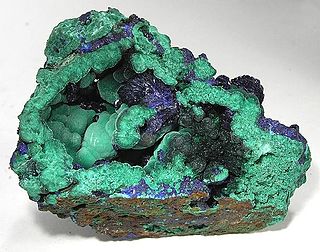
Green pigments are the materials used to create the green colors seen in painting and the other arts. Most come from minerals, particularly those containing compounds of copper. Green pigments reflect the green portions of the spectrum of visible light, and absorb the others. Important green pigments in art history include Malachite and Verdigris, found in tomb paintings in Ancient Egypt, and the Green earth pigments popular in the Middle Ages. More recent greens, such as Cobalt Green, are largely synthetic, made in laboratories and factories.

Azurite is an inorganic pigment derived from the mineral of the same name. It was likely used by artists as early as the Fourth Dynasty in Egypt, but it was less frequently employed than synthetically produced copper pigments such as Egyptian Blue. In the Middle Ages and Renaissance, it was the most prevalent blue pigment in European paintings, appearing more commonly than the more expensive ultramarine. Azurite's derivation from copper mines tends to give it a greenish hue, in contrast with the more violet tone of ultramarine. Azurite is also less stable than ultramarine, and notable paintings such as Michelangelo's The Entombment have seen their azure blues turn to olive green in time. Azurite pigment typically includes traces of malachite and cuprite; both minerals are found alongside azurite in nature, and they may account for some of the green discoloration of the pigment. The particle size of azurite pigment has been shown to have a significant effect on its chromatic intensity, and the manner of grinding and preparing the pigment therefore has a major impact on its appearance.
References
- ↑ Oldershaw, Cally (2003). Firefly Guide to Gems. Firefly Books. p. 80. ISBN 978-1-55297-814-6.
- ↑ Manutchehr-Danai, Mohsen (2013-03-09). Dictionary of Gems and Gemology. Springer Science & Business Media. p. 33. ISBN 978-3-662-04288-5.
- ↑ Hobart M. King. "Azurmalachite". geology.com. Retrieved 14 August 2021.